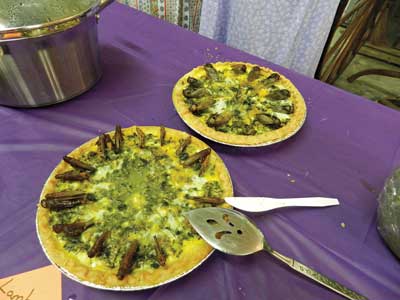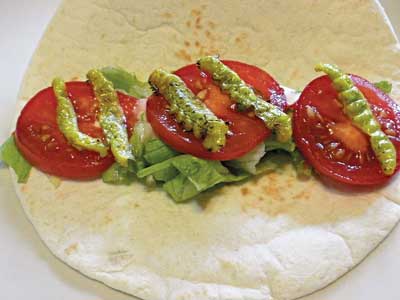 |
| Lambsquarters quiches garnished with crickets (front) and cicadas (back). Photo by Paul Landkamer; used with permission |
 |
| Tomato hornworm wrap, with lettuce and tomatoes. Photo by Jake Reed; used with permission |
By Sue Smith-Heavenrich
Last year was tough on my garden. Between the heat and the lack of rain, about the only things I reliably produced were insects. One morning after knocking Japanese beetles off the bean plants, I stared at the cup of soggy protein covering the bottom of my bucket. Too bad I couldn’t eat them.
“You could,” says Paul Landkamer. “They make good croutons.” Landkamer, a master naturalist in Missouri, experiments with entomophagy – the practice of eating insects. He also curates the Missouri Entomophagy Facebook page. Dried beetles, he says, add crunchiness and flavor to fresh garden salads, plus extra protein.
Most of the insects bugging our plants are edible, says Landkamer, but you have to know what you’re collecting. Don’t nosh on brightly colored insects – they wear warning colors for a reason. Other than those, Landkamer is all for turning the tables on garden pests – even stink bugs. “If you can’t beat ‘em, eat ‘em,” he says.
Garden Grub
Japanese beetles are in the scarab family, which includes dung beetles, June beetles and rose chafers. They’re all edible, says Landkamer. He suggests popping bugs into the freezer for 20 minutes so that they don’t fly away when you try to cook them. Then rinse the beetles in a colander and gently boil for 5 to 10 minutes.
At this point, Landkamer pours a marinade over them and puts them in the fridge overnight. The next day he puts the beetles in his dehydrator and, once they’re crunchy, packs them into freezer bags for storage.
To roast beetles, spread them on a cookie sheet and put them into a 200 F oven for an hour or so until they’re crunchy. Now they’re ready to be added to soups, stews, used as pizza toppings or tossed into salads and quiches. You can crush them with a spoon and stir them into a chip dip or add beetle bits to popcorn.
Beetle larvae (grubs) go well in stir-fries, tacos and similar dishes. Because they have soil in their guts, some people like to purge larvae before cooking them, feeding them vegetable and fruit rinds, or oats for a day or two. Grated carrots, says Landkamer, give some insects a sweeter taste. Once rinsed, grubs can be tossed into the frying pan and sautéed.
Fried Green Tomato Hornworms
Hornworms are the caterpillars of a family of moths called sphinx moths or hawk moths, and they get quite big – up to 3 or 4 inches long. Since they’ve been feasting on tomato leaves all summer, you might wonder whether they taste like green tomatoes. According to folks who’ve tried them, the answer is yes. Landkamer boils and dehydrates his, but other people fry theirs with tomatoes and basil. The trick is to fry them at high heat and not too long, because they lose their color and sometimes pop open. Hornworms are so meaty that they are often added to soups and stews.
Armyworms, corn earworms, cutworms, cabbageworms and loopers also provide possibilities for caterpillar cuisine. People have purged caterpillars with varied success, but Landkamer doesn’t bother. They’ve been eating your garden plants so they’re probably okay, he says. Just toss them in the stir fry with your garden veggies.
If going 100 percent buggy is too much for now, fry the insects along with other meat. Think about using soft-bodied larvae in curries, spaghetti sauce and chili. Because insects are related to shellfish, some might have a shrimpy taste, so experiment with your seasonings.
Grasshoppers, locusts and crickets are fair game for the garden entomophagist, too. Most people pull off the wings and legs before cooking, but Landkamer doesn’t bother. Boiling them softens the exoskeleton just enough so that they have a nice crunch once they’ve been dehydrated, he says. Chapulines are grasshoppers toasted with garlic and lime juice, then served in a warm tortilla. Stir-fried, roasted, dried or toasted, crickets and grasshoppers make great pizza toppings.
Why Eat Bugs?
Aside from karmic payback, why bother eating bugs? For one thing, insects provide good protein, vitamins and minerals. They’re just as nutritious as fish and other meat. Pound for pound, insects require less water, land and feed to produce protein, and, concludes a recent United Nations report, raising insects for food could help stamp out world hunger. Farming crickets and other “mini-livestock” could also serve as a more climate-friendly alternative with respect to greenhouse gas emissions.
Beware of Bad Bugs
If you are worried that eating bugs could be dangerous, consider that 3 billion people around the world already chow down on edible insects every day. Still, the beginning bug eater should take some precautions.
First, know your insects. You wouldn’t eat a mushroom without properly identifying it, so get to know the edible insects.
Second, if you are allergic to shellfish, avoid eating insects. Because insects and crustaceans belong to a huge and diverse phylum – arthropods – they share common allergens.
Pay attention to colors. Brown or green bugs are usually okay to eat. Bright orange, yellow or red insects: Let them be. Those warning colors let predators know that the insects are unpalatable or poisonous. So don’t eat ‘em. Also be careful of caterpillars with stinging hairs. And although people can eat milkweed pods and flowers, it’s probably best to avoid the insects that feed on the sap of this plant.
Know where your insects come from. Like fish and shellfish, insects can bioaccumulate chemicals, so make sure that insects you collect come from an area where there is no spraying or dangerous chemical use. For that reason, most people advise that you raise your own insects or buy them from an insect farm. If you’re looking for farm-raised insects in Maine, check out EntoMarket (edibleinsects.com) in Auburn.
Last but not least, cook freshly harvested bugs before you eat them.
How to Catch Your Dinner
Sweep nets are useful for catching flying insects, such as locusts in hayfields, but the best way to collect grasshoppers is to head out on a cool night. “Grasshoppers climb up high weeds,” says Landkamer. “You can pick them off like berries.”
The easiest way to collect Japanese beetles is with a funnel trap. Cut the top off a 2-liter soda bottle and invert it into the remainder of the bottle, then knock the beetles in. Use a Ping-Pong ball for a stopper.
Recipes
Paul Landkamer’s Insect Marinade
Landkamer loves General Tso’s chicken so much that he tried to copy the sauce without using a recipe. The result tastes nothing like Chinese take-out, but it’s now his favorite marinade and he calls it “fish and rice” sauce. He uses it to marinate beetles and crickets, grasshoppers, cicadas – even stink bugs.
Mix together and let sit overnight:
1/4 c. hot pepper sauce (Tabasco)
1/4 c. soy or Worcestershire sauce
1/4 c. water
3/4 c. sugar
4 tsp. garlic powder
1 tsp. ground ginger
1 Tbsp. cumin
Chirpy-chip Cookies
The quickest way to insect love is through the tummy. Toss some roasted crickets or mealworms into your favorite cookie or brownie recipe. Here’s a chirpy take on the traditional chocolate-chip cookies.
1 c. softened butter or margarine
1/2 c. granulated sugar
1/2 c. brown sugar
1/2 c. powdered instant milk
2 eggs
1 tsp. vanilla
2 1/4 c. flour
1 tsp. baking soda
2 c. semisweet chocolate chips
1/2 c. roasted crickets (can substitute crumbled roasted mealworms)
Preheat oven to 375 F. Mix butter, sugars and powdered milk until smooth. Beat in eggs and vanilla. Add flour and baking soda, and mix. Stir in chocolate chips and crickets. Drop rounded tablespoons of cookie dough onto ungreased baking sheets. Bake for 9 to 11 minutes. Cool on baking sheets for 2 minutes before moving to cooling racks.
Books for the Backyard Bug-eater
“Garden Insects of North America,” by Whitney Cranshaw
“The Eat-a-Bug Cookbook,” by David George Gordon
“Creepy Crawly Cuisine,” by Julieta Ramos-Elorduy
“The Insect Cookbook, Food for a Sustainable Planet,” by Arnold VanHuis et al.
About the author: Sue Smith-Heavenrich lives and gardens in upstate New York. She plants flowers for beneficial insects and pollinators but is tired of feeding bugs who don’t pull their weight. Sue has eaten insects, some intentionally, and will be testing “Pest-o” recipes this summer.
